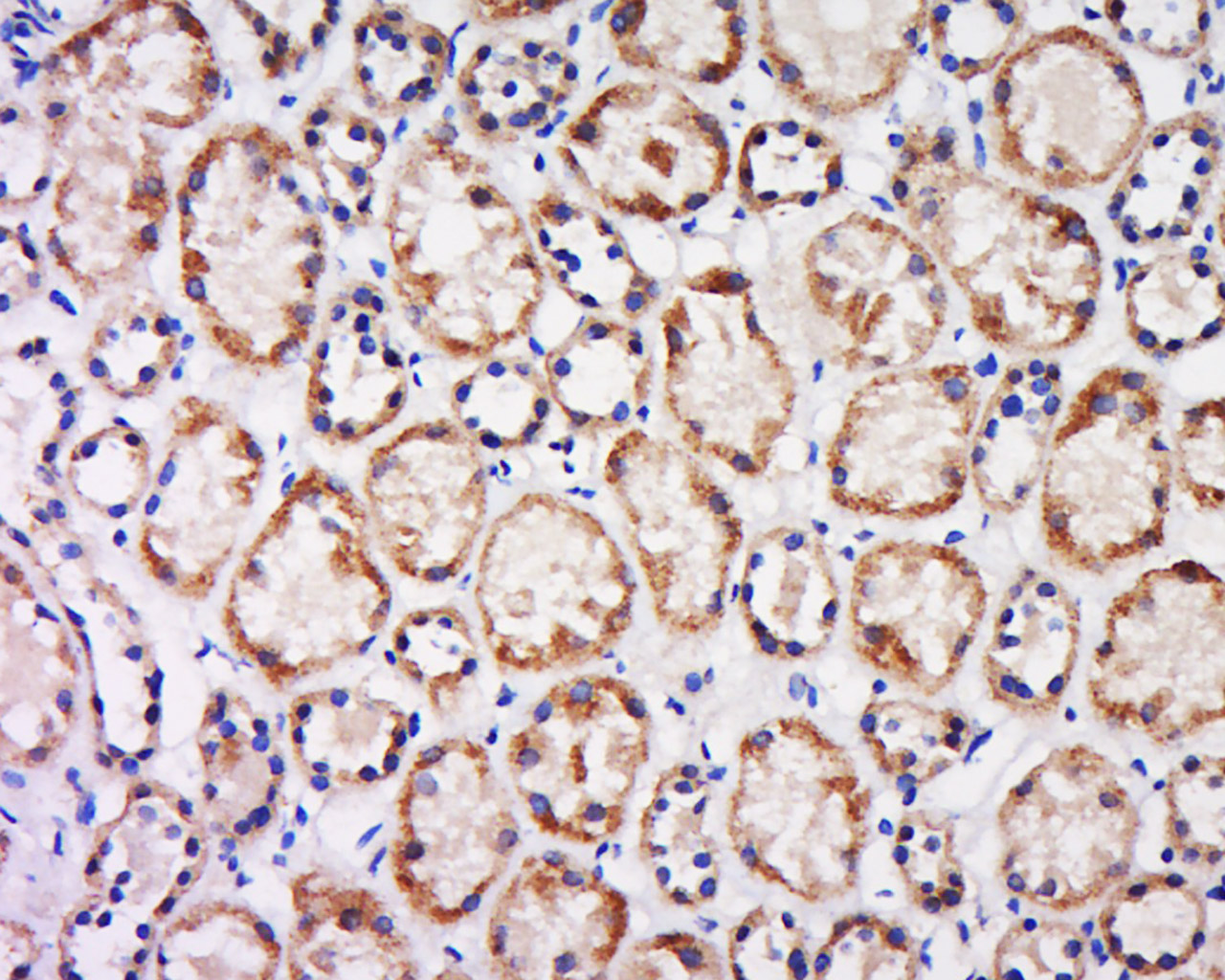
Rabbit Anti-CX3CL1 antibody
C3Xkine; Chemokine C X3 C motif ligand 1; Chemokine CX3C Motif Ligand 1; CX3C membrane anchored chemokine; CXC 3; CXC3; CXC3C; FKN; Fractalkine; Neurotactin; NTN; NTT; SCYD 1; SCYD1; Small inducible cytokine D1; Small inducible cytokine subfamily D (Cys X
View History [Clear]
Details
Product Name CX3CL1 Chinese Name CX3CL1抗体 Alias C3Xkine; Chemokine C X3 C motif ligand 1; Chemokine CX3C Motif Ligand 1; CX3C membrane anchored chemokine; CXC 3; CXC3; CXC3C; FKN; Fractalkine; Neurotactin; NTN; NTT; SCYD 1; SCYD1; Small inducible cytokine D1; Small inducible cytokine subfamily D (Cys X3 Cys) member 1; Small inducible cytokine subfamily D member 1; X3CL1_HUMAN. literatures Research Area Cardiovascular immunology Immunogen Species Rabbit Clonality Polyclonal React Species Human, (predicted: Mouse, Rat, ) Applications ELISA=1:5000-10000 IHC-P=1:100-500 IHC-F=1:100-500 ICC=1:100-500 IF=1:100-500 (Paraffin sections need antigen repair)
not yet tested in other applications.
optimal dilutions/concentrations should be determined by the end user.Theoretical molecular weight 41kDa Cellular localization The cell membrane Secretory protein Form Liquid Concentration 1mg/ml immunogen KLH conjugated synthetic peptide derived from human CX3CL1: 301-397/397 <Extracellular> Lsotype IgG Purification affinity purified by Protein A Buffer Solution 0.01M TBS(pH7.4) with 1% BSA, 0.03% Proclin300 and 50% Glycerol. Storage Shipped at 4℃. Store at -20 °C for one year. Avoid repeated freeze/thaw cycles. Attention This product as supplied is intended for research use only, not for use in human, therapeutic or diagnostic applications. PubMed PubMed Product Detail CX3CL1 is a member of the delta chemokine subfamily that contains a unique CX3C cysteine motif near the N-terminal. Unlike other known chemokines, it is a type 1 membrane protein containing a chemokine domain tethered on a long mucin-like stalk. CX3CL1, a leukocyte chemoattractant, is expressed in various tissues including the brain, heart, lung, kidney, skeletal muscle, and testis. The expression is reported to be up-regulated in endothelial cells and microglia by inflammatory signals. CX3CR1, a specific receptor for fractalkine, mediates both leukocyte migration and adhesion.
Function:
The soluble form is chemotactic for T-cells and monocytes, but not for neutrophils. The membrane-bound form promotes adhesion of those leukocytes to endothelial cells. May play a role in regulating leukocyte adhesion and migration processes at the endothelium. Binds to CX3CR1.
Subunit:
Monomer.
Subcellular Location:
Cell membrane; Single-pass type I membrane protein. Processed fractalkine: Secreted.
Tissue Specificity:
Small intestine, colon, testis, prostate, heart, brain, lung, skeletal muscle, kidney and pancreas.
Post-translational modifications:
A soluble short 95 kDa form may be released by proteolytic cleavage from the long membrane-anchored form.
O-glycosylated with core 1 or possibly core 8 glycans.
Similarity:
Belongs to the intercrine delta family.
SWISS:
P78423
Gene ID:
6376
Database links:Entrez Gene: 6376 Human
Entrez Gene: 20312 Mouse
Omim: 601880 Human
SwissProt: P78423 Human
SwissProt: O35188 Mouse
Unigene: 531668 Human
神经趋化蛋白cx3cl1免疫应答应答及细胞附着,参与cell factor和Chemokine介导Signal transduction、免疫细胞趋化性、调控炎症应答反应、白细胞附着激活、正调控钙非依赖细胞附着。Product Picture
Antigen retrieval: citrate buffer ( 0.01M, pH 6.0 ), Boiling bathing for 15min; Block endogenous peroxidase by 3% Hydrogen peroxide for 30min; Blocking buffer (normal goat serum,C-0005) at 37℃ for 20 min;
Incubation: Anti-CX3CL1 Polyclonal Antibody, Unconjugated(SL0811R) 1:500, overnight at 4°C, followed by conjugation to the secondary antibody(SP-0023) and DAB(C-0010) staining
Bought notes(bought amounts latest0)
No one bought this product
User Comment(Total0User Comment Num)
- No comment



 +86 571 56623320
+86 571 56623320
 +86 18668110335
+86 18668110335

